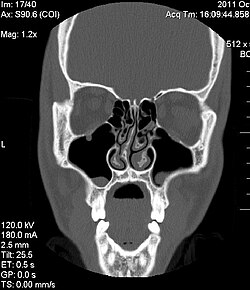Deformities of the nose and nasal septum
Disproportions in the shape, size and growth of its individual parts are the basis for deformities of the nose . They represent both a cosmetic defect that can lead to a social handicap, and they can also be the basis for a functional disorder.
They could be:
- gendered,
- developmental,
- traumatic,
- cancerous,
- operating.
Deformities of the external nose[edit | edit source]
The terminology used in the description is the same as for the spine. These include rhinokyphosis, rhinolordosis (saddle nose) and rhinoscoliosis (ace nose). Furthermore, we can encounter a nose that is excessively wide, high, long or narrow.
Fluttering nasal wings can be sucked in during inspiration, making it worse.
Deformities of the nasal septum[edit | edit source]
Deflection of the nasal septum[edit | edit source]
It can be unilateral or bilateral. A deviation in the area of the columella is also referred to as subluxatio septi nasi. Most deviations are caused by trauma or disproportionate growth.
Deviations are manifested by nasal obstruction and, less often, by olfactory disturbances and headaches. As a result of the changed dynamics of the air flow, traumatization of the mucous membrane and its trophic changes easily occur. This condition can also be responsible for a malfunction of the ventilation of the paranasal sinuses and the middle ear and can thus be involved in many pathological conditions (snoring, secretions, recurrent inflammation,...).
Buckling may also be accompanied by a crest on the septum ( crista septi nasi ) or a spine ( spina septi nasi ).
Perforation of the nasal septum[edit | edit source]
It occurs during drug abuse (snorting) or postoperatively.
Treatment of deformities[edit | edit source]
Treatment of deformities is in most cases surgical.
By approach:
- closed approach - intranasal incision only,
- open approach - also external incision.
According to the technique used:
- resection,
- augmentation,
- remodeling .
According to the operated structure:
- nasal septum surgery (septoplasty),
- nasal valve surgery,
- surgery of the nasal shells (turbinoplasty),
- nose tip surgery,
- alar base surgery,
- bone and cartilaginous vault surgery.
Septoplasty - the goal is to restore nasal patency.
Corrective rhinoplasty - correction of the nasal skeleton, it can be open or closed.
Reconstructive rhinoplasty - replacement of missing tissue (skeleton or soft tissue), using flaps and grafts.
Links[edit | edit source]
Related Articles [ edit | edit source ][edit | edit source]
References[edit | edit source]
- HYBÁŠEK, Ivan. Otorhinolaryngology. VERSION I edition. 2019. ISBN 1803-280X.


